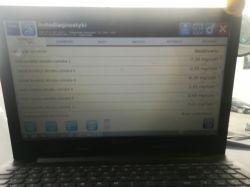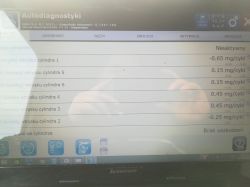Procedure when "vehicle smokes black"
Basically it is necessary to determine in what operating condition black smoke is present:
- Does the engine always smoke?
- Do they only smoke when accelerating?
So far, the following possible causes have been identified:
- Installation error, injector strained
- Leakage between the combustion chamber and the drainage pipe, lower injector seal
(CU O-ring) leaking
- Injector wear (large amounts of leaks)
- Incorrect projection of the nozzles
If black smoke was found during the test drive, we recommend the following
procedure:
- Read error memory EDC7
- If errors are stored, analyze them according to the troubleshooting guide and repeat the ride
trial.
If the vehicle continues to smoke black and the fault memory is empty:
- Experience has shown that in low-mileage engines, black smoke can be induced by
injectors mounted under tension
Remedy: Loosen all pressure pipe and injector fasteners then carefully
tighten. If this does not work as expected, it causes smoke when accelerating
the injectors may be worn.
Therefore, carry out the individual measurements and replace the corresponding injector.
- If the turbocharger is damaged earlier, oil may also be forced into the exhaust silencer.
It can also cause black smoke when accelerating.
Solution: Replace exhalation.
If there is still black smoke:
- Carry out the RPM increase test at least twice
If the RPM increase test is successful:
- Remove all injectors and
- check the seal in the nozzle area (CU ring seal) for dryness
- Check the diameters of the CU ring seals
If one or more injectors are found to be leaking and / or o-rings
CUs are too large in diameter:
- Replace the O-rings and pressure pipe stubs and reassemble them correctly
injectors
- Carry out a road test Procedure when "vehicle smokes black"
Basically it is necessary to determine in what operating condition black smoke is present:
- Does the engine always smoke?
- Do they only smoke when accelerating?
So far, the following possible causes have been identified:
- Installation error, injector strained
- Leakage between the combustion chamber and the drainage pipe, lower injector seal
(CU O-ring) leaking
- Injector wear (large amounts of leaks)
- Incorrect projection of the nozzles
If black smoke was found during the test drive, we recommend the following
procedure:
- Read error memory EDC7
- If errors are stored, analyze them according to the troubleshooting guide and repeat the ride
trial.
If the vehicle continues to smoke black and the fault memory is empty:
- Experience has shown that in low-mileage engines, black smoke can be induced by
injectors mounted under tension
Remedy: Loosen all pressure pipe and injector fasteners then carefully
tighten. If this does not work as expected, it causes smoke when accelerating
the injectors may be worn.
Therefore, carry out the individual measurements and replace the corresponding injector.
- If the turbocharger is damaged earlier, oil may also be forced into the exhaust silencer.
It can also cause black smoke when accelerating.
Solution: Replace exhalation.
If there is still black smoke:
- Carry out the RPM increase test at least twice
If the RPM increase test is successful:
- Remove all injectors and
- check the seal in the nozzle area (CU ring seal) for dryness
- Check the diameters of the CU ring seals
If one or more injectors are found to be leaking and / or o-rings
CUs are too large in diameter:
- Replace the O-rings and pressure pipe stubs and reassemble them correctly
injectors
- Carry out a road test Procedure when "vehicle smokes black"
Basically it is necessary to determine in what operating condition black smoke is present:
- Does the engine always smoke?
- Do they only smoke when accelerating?
So far, the following possible causes have been identified:
- Installation error, injector strained
- Leakage between the combustion chamber and the drainage pipe, lower injector seal
(CU O-ring) leaking
- Injector wear (large amounts of leaks)
- Incorrect projection of the nozzles
If black smoke was found during the test drive, we recommend the following
procedure:
- Read error memory EDC7
- If errors are stored, analyze them according to the troubleshooting guide and repeat the ride
trial.
If the vehicle continues to smoke black and the fault memory is empty:
- Experience has shown that in low-mileage engines, black smoke can be induced by
injectors mounted under tension
Remedy: Loosen all pressure pipe and injector fasteners then carefully
tighten. If this does not work as expected, it causes smoke when accelerating
the injectors may be worn.
Therefore, carry out the individual measurements and replace the corresponding injector.
- If the turbocharger is damaged earlier, oil may also be forced into the exhaust silencer.
It can also cause black smoke when accelerating.
Solution: Replace exhalation.
If there is still black smoke:
- Carry out the RPM increase test at least twice
If the RPM increase test is successful:
- Remove all injectors and
- check the seal in the nozzle area (CU ring seal) for dryness
- Check the diameters of the CU ring seals
If one or more injectors are found to be leaking and / or o-rings
CUs are too large in diameter:
- Replace the O-rings and pressure pipe stubs and reassemble them correctly
injectors
- Carry out a road test Procedure when "vehicle smokes black"
Basically it is necessary to determine in what operating condition black smoke is present:
- Does the engine always smoke?
- Do they only smoke when accelerating?
So far, the following possible causes have been identified:
- Installation error, injector strained
- Leakage between the combustion chamber and the drainage pipe, lower injector seal
(CU O-ring) leaking
- Injector wear (large amounts of leaks)
- Incorrect projection of the nozzles
If black smoke was found during the test drive, we recommend the following
procedure:
- Read error memory EDC7
- If errors are stored, analyze them according to the troubleshooting guide and repeat the ride
trial.
If the vehicle continues to smoke black and the fault memory is empty:
- Experience has shown that in low-mileage engines, black smoke can be induced by
injectors mounted under tension
Remedy: Loosen all pressure pipe and injector fasteners then carefully
tighten. If this does not work as expected, it causes smoke when accelerating
the injectors may be worn.
Therefore, carry out the individual measurements and replace the corresponding injector.
- If the turbocharger is damaged earlier, oil may also be forced into the exhaust silencer.
It can also cause black smoke when accelerating.
Solution: Replace exhalation.
If there is still black smoke:
- Carry out the RPM increase test at least twice
If the RPM increase test is successful:
- Remove all injectors and
- check the seal in the nozzle area (CU ring seal) for dryness
- Check the diameters of the CU ring seals
If one or more injectors are found to be leaking and / or o-rings
CUs are too large in diameter:
- Replace the O-rings and pressure pipe stubs and reassemble them correctly
injectors
- Carry out a road test





